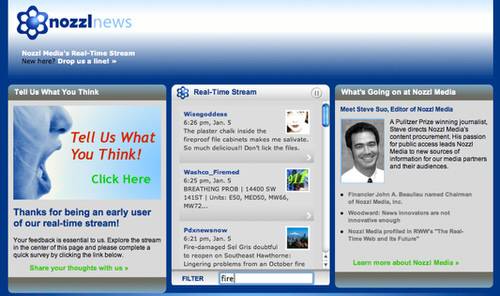One hour ago, three emergency vehicles responded to a report of an unconscious person at the world headquarters of Nike Inc. in Portland, Oregon. How do I know? An automated form-pumping robot from startup company Nozzl Media told me.

Nozzl Media today unveiled a demonstration of its first product, a widget intended for newspaper websites seeking to display real-time local information derived from Twitter messages, blog posts and automatically extracted public records like restaurant health inspections, building reports and public safety emergency responses. It’s like a little robot reporter and the company plans on offering it as a mobile app in the future as well. Nozzl raises questions, though, about what constitutes news and whether or not human reporters are expendable in the news process.

Nozzl was founded by a team of ex-newspaper reporters and engineers. They got out when it was clear the newspaper industry was in trouble, but now they aim to give something back by bringing together the real-time, programmatic possibilities of the web with the reporting of the newspapers. Reporters have for decades written programming scripts that repeat database queries over and over again to extract public data for bulk analysis. The Nozzl team has taken that to the next level and combined it with new social media.
The company put up a demo page for Portland, Oregon news that anyone can look at today. The public records streams are the big value-add and are fully customizable per newspaper. Visitors can then type live filter terms into the box at the bottom of the widget to zero in on topics of interest to them. That’s the nozzle in Nozzl Media.
User Experience is Hard For Robots
Unfortunately, there are two big issues here. First, the flow of Tweets is overwhelming and undifferentiated. On the demonstration site you see almost nothing else unless you can think of something to filter for. If automated Twitter feeds hold value for local news, they will probably require some smart pre-proccessing before being presented to the reading public.
There have always been people who like to listen to police radio scanners. Myself, I like to read restaurant health inspection reports, building permit applications and liquor license applications. If Nozzl had some categories I could choose between, that would be very helpful.
The second, and more interesting, problem is that the public records that are extracted are exciting in theory but relatively unreadable in practice. The truth is, Nozzl didn’t exactly tell me that there was an unconscious person reported at Nike HQ today – it told me with code from a form that there was an UNCONS/UNRESPONSIVE report at 1 SW Bowerman Drive, in Portland.
A little Mad-Libs style transformation of forms into human-readable sentences and some pre-fetching of names associated with addresses could go a long way. Run the name associated with that address through a News search engine and tell me if it’s an entity that’s been reported on in the past – if so then it’s probably high-priority news to push live again. The company needs to put these machine-readable pages it displays into coherent English sentences, or find some other solution.
Don’t Forget the Humans
Ambulances to Nike’s Headquarters to help someone unconscious today? That sounds like it could be news. Even if the technology presented the information this clearly – it may take a human eye to pick a story like that out of a list of automatically captured ambulance reports. Having a human available to pick up a phone, call Nike HQ and ask who was found unconscious there this afternoon would add another element of value to this data – but that’s not what Nozzl is looking to do. The company is serving up raw data to news consumers.
In the end, human reporters and raw robot feeds sound like a great combination. That appears to be what Nozzl is aiming to create by offering its widgets to established news organizations. The company says that a mobile application could be in its future, too. That’s something I’m very excited about. Be it a widget or a mobile app, Nozzl’s robot reporters need more polish before they are ready to win back the hearts of fast-leaving newspaper readers. As a picture of the future, though – Nozzl is very inspiring.
Interested in what companies like Nozzl Media mean for the future of the web? Check out our profile of Nozzl and ten other case study companies in our recent research report The Real-Time Web and Its Future.





















